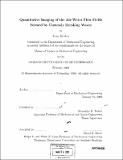Quantitative imaging of the air-water flow fields formed by unsteady breaking waves
Author(s)
Belden, Jesse (Jesse Levi)
DownloadFull printable version (39.31Mb)
Other Contributors
Massachusetts Institute of Technology. Dept. of Mechanical Engineering.
Advisor
Alexandra H. Techet.
Terms of use
Metadata
Show full item recordAbstract
An experimental method for simultaneously measuring the velocity fields on the air and water side of unsteady breaking waves is presented. The method is applied to breaking waves to investigate the physics of the air and water flow fields to further our knowledge of the impact of wave breaking on air-sea interaction. The method includes a novel technique for seeding the air flow such that the air velocity can be resolved in the absence of wind. Low density particles which have large Stokes drag and ability to respond to high frequency flow fluctuations are used to seed the air flow. Multi-camera, multi-laser particle image velocimetry (PIV) setups are applied to small-scale shoaling breaking waves, yielding fully time-resolved velocity fields. The surface tension of the fluid is altered and controlled to form both spilling and plunging breaking waves. Application of the developed experimental method to these breaking waves reveals interesting flow physics in the air and water. Results for the velocity and vorticity fields on the water side show qualitative agreement to published data, and comparisons are drawn where applicable. Quantitative experimental data for the air flow induced by wave breaking in the absence of wind has not previously been observed, to the author's knowledge. Revealing physical insights and observations are drawn from this novel data.
Description
Thesis (S.M.)--Massachusetts Institute of Technology, Dept. of Mechanical Engineering, 2009. Includes bibliographical references (p. 97-101).
Date issued
2009Department
Massachusetts Institute of Technology. Department of Mechanical EngineeringPublisher
Massachusetts Institute of Technology
Keywords
Mechanical Engineering.